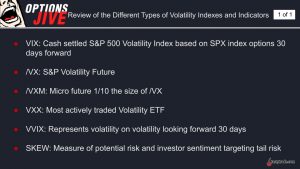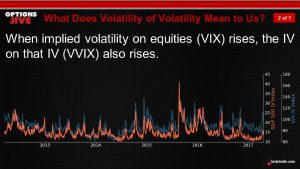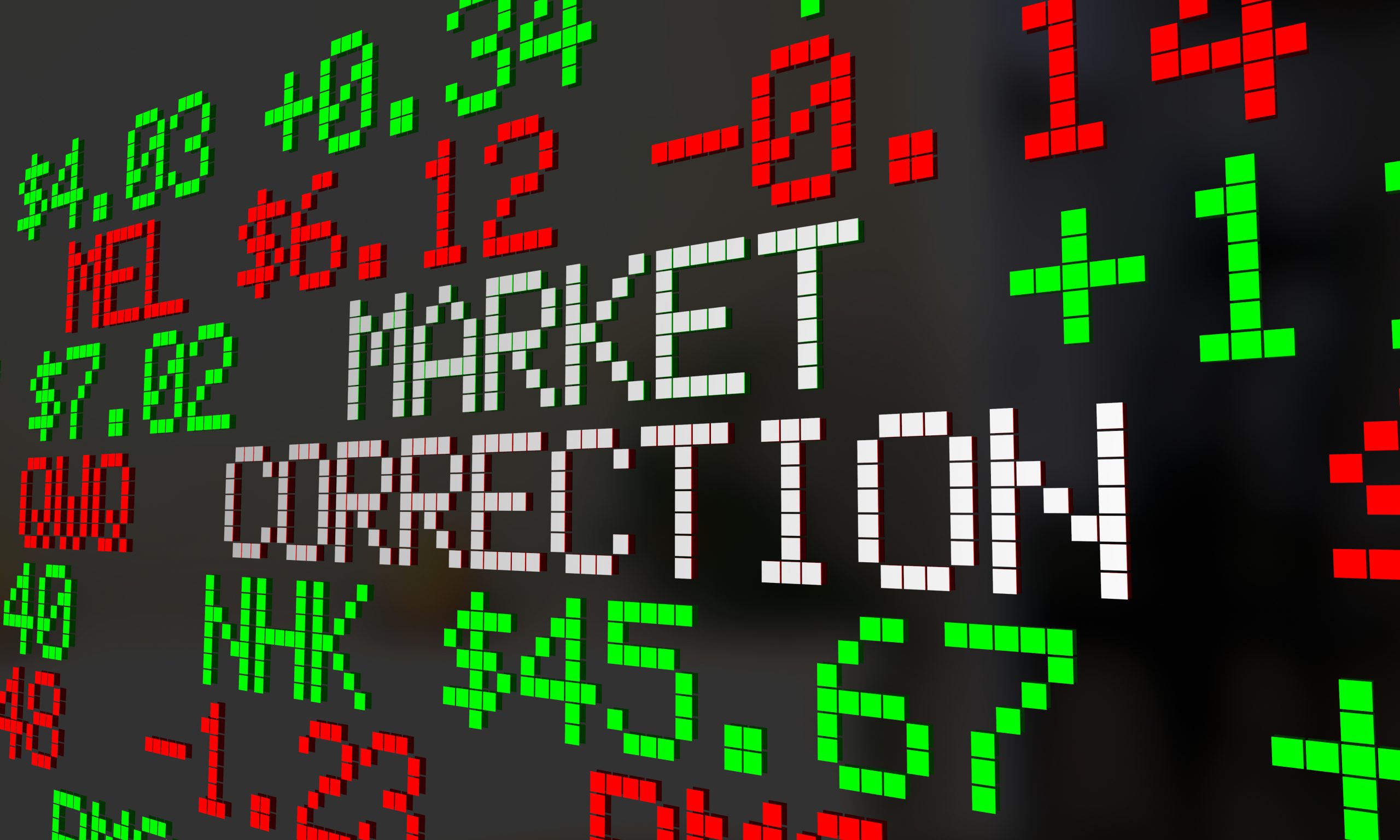Trading the Recent Spike in Market Volatility
A sharp spike in market volatility during the fall of 2021 has put the sector in focus, with renewed attention on products like VIX, VXX, VVIX, UVXY and SVXY.

After many months of relative complacency, volatility has become the new watchword on Wall Street. As a result, investors and traders are turning to the volatility space this fall to track and trade developing opportunities.
In that spirit, today’s post reviews some of the most visible, and highest volume, volatility-focused products in the market.
Of course, the list begins with the CBOE Volatility Index (VIX), but there’s a handful of other volatility metrics that market participants should likely be following, as well.

The VIX represents a theoretical weighted blend of prices on a range of OTM options in the S&P 500 index. The value of the VIX index therefore changes with the demand for these options, which is why it is said to reflect the market’s appetite for risk.
Indices like the VIX were created to track changes in the volatility value of options that essentially reflect changes in the market’s perception of risk.
Therefore, if the extrinsic value of OTM options increases due to demand, the VIX will go higher. If the extrinsic value of OTM options decreases to a drop in demand for the option, the VIX will go lower.
It’s important to note that while traders can’t trade the actual VIX Index, they can trade VIX futures and VIX options. And in terms of practical application, VIX futures and VIX options can be used in a variety of ways.
For example, if a trader has sold premium in high IV options across a group of single stocks or ETFs, he or she might consider buying VIX options or futures to hedge their overall portfolio. This might be particularly attractive if VIX implied volatility is cheap and/or if the absolute level for VIX is historically low.
Under this scenario (short premium portfolio, long VIX futures), an increase in volatility would put pressure on the short premium portfolio of options, but a likely increase in the value of the VIX futures would help mitigate those losses.
In the reverse scenario, in which volatility decreases, the profits from a short premium portfolio of options would likely outweigh, if scaled appropriately, any losses in the VIX position.
It should be noted that there is not a generally accepted mathematical relationship between the spectrum of months in listed VIX futures—which is why calendar spreads in this instrument are not recommended.
Interestingly, the recent bout in market volatility hasn’t actually pushed the VIX to an extreme.
As of Oct. 5, the VIX closed trading at roughly 21, only three points higher than its long-term, historical average. The 52-week range in VIX is between 14 and 41.
iPath Series B S&P 500 VIX Short-Term Futures ETN (VXX)
The next most-cited volatility measurement/product after the VIX is arguably the iPath Series B S&P 500 VIX Short-Term Futures ETN (VXX), which is an Exchange-Traded Note (ETN).
Exchange-Traded Notes and Exchange-Traded Funds (ETFs) act much like listed stocks on an exchange. ETNs such as VXX are designed to provide investors with the return of a market benchmark.
The benchmark that VXX tracks is the S&P 500 VIX Short-Term Futures Total Return Index, which in itself is a 30-day estimator of VIX futures (/VX). Because the VXX is an ETN, fund administrators adjust the security on a daily basis by selling front-month VIX futures and buying second-month VIX futures.
Taken together, that means the VXX is concentrated on short-term changes in volatility, due to its focus on the first two months of /VX futures.
The need for the VXX to trade in and out of the front two positions also means that it won’t mimic the performance of VIX futures identically—an effect that is referred to as “drag.”
One can visualize this “drag” phenomenon by imagining VXX administrators selling the cheaper front month VIX futures and buying the more expensive second month VIX futures during contango.
And the net result is that while the VIX and VXX are highly correlated, the total returns of the two will vary, at times significantly. Currently, the VXX is trading for roughly 27.5. The 52-week range in VXX is between 24 and 111.
CBOE VIX VOLATILITY INDEX (VVIX)
Another important volatility metric often followed by investors and traders is the CBOE VIX Volatility Index (VVIX).
The VVIX is calculated using the implied volatility of options in the VIX itself. The VVIX is therefore said to measure the “volatility of volatility, or the “vol of vol.”
Thinking through the mechanics of the VIX and VVIX, it stands to reason that as the VIX rises, the VVIX should also go higher (and vice versa). This relationship is illustrated in the chart below, using historical data in VIX and VVIX:

Interestingly, while VIX and VVIX are closely intertwined, they are not perfectly correlated. An examination of the historical correlation between the two by tastytrade revealed a correlation of about 0.75.
Those wondering why the two don’t always move together might imagine the following hypothetical situation. If VIX were to spike to 49, as it did in 2020, one could safely assume the VVIX would also make a big move higher (and it did).
Now imagine that the VIX were to drop from 45 to 43. In this case, it’s entirely possible that implied volatility reported by VVIX would not decline, given that a VIX reading above 40 still qualifies as well above its historical average.
Implied volatility in VIX options might under this scenario remain firmly bid given that the VIX could still theoretically make a big move in either direction. This is just one example of a situation in which VIX and VVIX might not move in perfect unison.
Investors and traders often track the VVIX/VIX ratio because historical spikes in this metric have predicated corrections in the stock market—although not in every instance.
The long-term average in the VIX is around 19, while the long-term average in the VVIX is about 88.
Historically, the VVIX/VIX ratio tends to be lower during periods of extreme volatility and higher during periods of relative complacency. In recent years, the VVIX/VIX ratio has ranged between roughly 2.5 and 10.
As of today, the VVIX/VIX ratio stands at around 5.6 (117/21 = 5.6) suggesting that the current risk environment hasn’t reached an extreme—at least in regards to this ratio.
ProShares Ultra VIX Short-Term Futures ETF (UVXY)
While the ProShares Ultra VIX Short-Term Futures ETF (UVXY) isn’t the same as the VXX, there are some similarities.
As with the VXX, the UVXY seeks to replicate the return of the VIX, but in this case its goal is 1.5x the VIX (the VXXB would be 1x the VIX).
The fact that UVXY seeks a 1.5x return is a good indicator of its true self—a leveraged Exchange-Traded Fund (ETF). The method by which the UVXY achieves its 1.5x mandate is by purchasing extra VIX futures (as compared to VXX) and also using margin (i.e. credit).
As with any investment that involves credit, that dynamic means there are added complications when trading UVXY, and traders should research the product thoroughly before getting involved. The UVXY can be bought, sold, or sold short like a stock, and also has listed options.
UVXY is currently trading around 24 and has a 52-week range between 20 and 232.
ProShares Short VIX Short-Term Futures ETF (SVXY)
While the VXX and UVXY are designed to replicate the returns of the VIX (1x and 1.5x, respectively), the ProShares Short VIX Short-Term Futures ETF (SVXY) hails from the family of inverse ETFs.
In practice, that means the SVXY is intended to move in the opposite direction of the VIX—to the tune of -0.5x. Generally speaking, the SVXY should therefore increase when volatility falls, and decrease when volatility increases.
Like VXX and UVXY, the SVXY can be bought, sold, or sold short like a stock, and also has listed options. SVXY is currently trading at 54 and has a 52-week range between 33 and 59.
Parting Thoughts
A great way to gain a better understanding of the relationship between all of the above volatility products is by watching how they move in comparison to each other across a diverse range of market conditions. Simply adding these tickers to the daily watchlist should in itself help one better understand how they move.
Readers seeking to learn more about the landscape of volatility products are encouraged to review a new installment of Options Jive on the tastytrade financial network.
This previous episode of Market Measures also provides great context on how these products move relative to one another. For updates on everything moving the markets, readers can tune into TASTYTRADE LIVE—weekdays from 7 a.m. to 4 p.m. CST—at their convenience.
Sage Anderson is a pseudonym. He’s an experienced trader of equity derivatives and has managed volatility-based portfolios as a former prop trading firm employee. He’s not an employee of Luckbox, tastytrade or any affiliated companies. Readers can direct questions about this blog or other trading-related subjects, to support@luckboxmagazine.com.



















